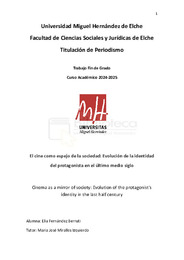Por favor, use este identificador para citar o enlazar este ítem:
https://hdl.handle.net/11000/37218Registro completo de metadatos
| Campo DC | Valor | Lengua/Idioma |
|---|---|---|
| dc.contributor.advisor | Miralles Izquierdo, Maria José | - |
| dc.contributor.author | Fernández Berruti, Elia | - |
| dc.contributor.other | Departamentos de la UMH::Ciencias Sociales y Humanas | es_ES |
| dc.date.accessioned | 2025-09-05T09:39:22Z | - |
| dc.date.available | 2025-09-05T09:39:22Z | - |
| dc.date.created | 2025-06 | - |
| dc.identifier.uri | https://hdl.handle.net/11000/37218 | - |
| dc.description.abstract | El cine siempre ha sido reconocido por su alto valor artístico y por ser algo mágico y especial que conecta a las personas a través de sus imágenes e historias. Pero, si se hace una reflexión un poco más profunda sobre qué más esconde, puede verse cómo sirve en muchas ocasiones como reflejo de la sociedad en la que se construye. A través de los personajes se muestran situaciones, preocupaciones, sentimientos, conflictos… que son capaces de despertar algo en el espectador precisamente por la empatía que este posee al ver una situación reconocible. A través de la sociología del cine y la psicología del mismo, se puede identificar la similitud que guarda con el contexto sociocultural y con qué herramientas lo muestra. Este análisis se fundamenta en algunas de las teorías más reconocidas de este campo que afirman que el cine es un claro espejo de la sociedad y que es una representación de la realidad que los humanos vivimos. Se lleva a cabo un enfoque mixto, combinando análisis cuantitativos y cualitativos, que considera a través de una selección de películas, basada en notas críticas y premios, cómo se pueden interpretar y qué relación guardan con el contexto social, político, económico o cultural desde la década de 1970 hasta 2020 en el cine estadounidense. El trabajo también explora las distintas realidades y principales manifestaciones que tuvieron lugar a lo largo de estas décadas con especial importancia en luchas por derechos civiles, la situación económica, política, social y tecnológica. Entonces, se analiza cómo según la época en la que nos encontremos, las películas y principalmente sus protagonistas, manifiestan unas u otras preocupaciones, necesidades o valores que cuadran con todo lo vivido entonces de alguna forma u otra. | es_ES |
| dc.description.abstract | Cinema has always been recognized for its high artistic value and for being something magical and special that connects people through its images and stories. But if we reflect a little more deeply on what lies beneath, we can see how it often serves as a reflection of the society in which it is constructed. Through its characters, situations, concerns, feelings, conflicts, and so on are shown, capable of awakening something in the viewer precisely because of the empathy they feel when witnessing a recognizable situation. Through the sociology of film and its psychology, we can identify its similarity to the sociocultural context and the tools it uses to portray it. This analysis is based on some of the most recognized theories in this field, which affirm that cinema is a clear mirror of society and a representation of the reality in which humans live. A mixed approach is adopted, combining quantitative and qualitative analyses. Through a selection of films based on critical reviews and awards, it considers how they can be interpreted and their relationship to the social, political, economic, and cultural context in American cinema from the 1970s to 2020. The work also explores the different realities and main manifestations that took place throughout these decades, with particular emphasis on civil rights struggles and the economic, political, social, and technological situation. It then analyzes how, depending on the era in which we find ourselves, films, and especially their protagonists, express certain concerns, needs, or values that fit with everything experienced at that time in one way or another. | es_ES |
| dc.format | application/pdf | es_ES |
| dc.format.extent | 67 | es_ES |
| dc.language.iso | spa | es_ES |
| dc.publisher | Universidad Miguel Hernández de Elche | es_ES |
| dc.rights | info:eu-repo/semantics/openAccess | es_ES |
| dc.rights | Attribution-NonCommercial-NoDerivatives 4.0 Internacional | * |
| dc.rights.uri | http://creativecommons.org/licenses/by-nc-nd/4.0/ | * |
| dc.subject | cine | es_ES |
| dc.subject | estadounidense | es_ES |
| dc.subject | protagonista | es_ES |
| dc.subject | película | es_ES |
| dc.subject | contexto sociocultural | es_ES |
| dc.subject | tiempo | es_ES |
| dc.subject | cinema | es_ES |
| dc.subject | american | es_ES |
| dc.subject | protagonist | es_ES |
| dc.subject | film | es_ES |
| dc.subject | sociocultural context | es_ES |
| dc.subject | time | es_ES |
| dc.subject.other | CDU::0 - Generalidades.::070 - Periódicos. Prensa. Periodismo. Ciencias de la información | es_ES |
| dc.title | El cine como espejo de la sociedad: Evolución de la identidad del protagonista en el último medio siglo | es_ES |
| dc.title.alternative | Cinema as a mirror of society: Evolution of the protagonist's identity in the last half century | es_ES |
| dc.type | info:eu-repo/semantics/bachelorThesis | es_ES |

Ver/Abrir:
TFG_PER-Fernández Berruti, Elia.pdf
1,51 MB
Adobe PDF
Compartir:
 La licencia se describe como: Atribución-NonComercial-NoDerivada 4.0 Internacional.
La licencia se describe como: Atribución-NonComercial-NoDerivada 4.0 Internacional.
.png)